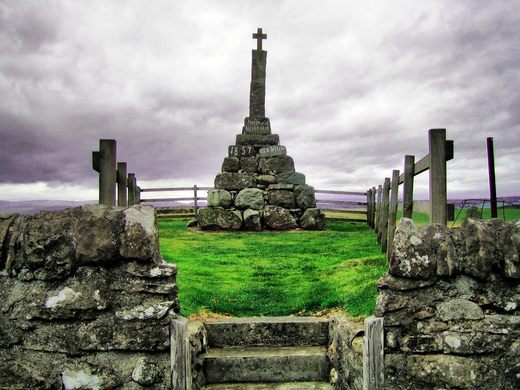about Scotland’s Darkest Secret
This is not just a book about witches, but about Scottish witches! And Halloween is mentioned many times.
Author Allyson Shaw, who has written much about folklore and history, now lives in Orkney, one of the islands north of the Scottish mainland. She tells of the Orkney Witches’ Charm, which includes the line “From the top of the head to the tip of the toes.” Shaw writes that “Many Scottish folk charms of healing and warding involve a promise from the top of the head to the toes. During the witch-hunts, this was demonized as a deal with the devil.”

Shaw goes on a search for witchcraft in Orkney. Historically, she does mot have to look far. The King of Scotland in the late 1500s was James VI (who later became King of England as well). He was so obsessed with witches, the king actually wrote about demons. In that book, he said witchcraft “was most common in such wild parts of the world as Finland, or in our North Isles of Orkney and Shetland.” During the 1600s, 81 people in Orkney were accused of being witches. More cases were just discovered in the archives three years ago. “Women confessed to meeting fairies, and these entities were turned to demons in the official records.”
Shaw tells of Elspeth, an unwed teenage mother. After giving birth at age 14, she was visited by a man in black. “Was this a human man? Or was he a fairy-man?” The man told her he was the ghost of her kinsman John. He said he would teach her special knowledge but this would make her mute. After the third of his nightly visits she woke up unable to speak. Sensing the presence of evil, her brother beat here and took het to Church three Sundays, “asking the congregation to pray for her.” All that was on the Scottish mainland; she fled to Orkney but the fairy-man followed. Shaw says he may have just been a dream figment, but he seemed real enough. Elspeth was one of several accused in Orkney who lost the power of speech. She was tried and executed in 1616 in the main Orkney town of Kirkwall. First, she was strangled at the stake, and then burnt to ashes.
Each chapter of the book focuses on a different victim in the 1600s and 1700s. “An estimated 4,000 people were formally accused and over 2,000 were executed. Considering the small population of Scotland (800,000 people), these numbers are sobering.” No one was safe; even men were convicted, but women represent close to 90% of the victims.
Shaw searches for stones throughout Scotland that in some way commemorate the witches. She gives us a moment-by-moment description of finding them, often covered by moss or hidden in forests. What is likely the largest one (shown in lead photo) is The Maggie Wall in the village of Dunning, SW of Perth (most historians believe Maggie Wall never existed): “The monument consists of iron supports holding a pile of stones together, topped with a cross of unknown origin. It first appears on a map in 1866.” Unfortunately, there are no illustrations in the book; this would have made the seek and find trips much more engaging.
“The records are full of wild claims that make little sense to a modern reader.” An accused named Agnes (in 1590) “confessed she had premonitions of the great storm that threatened the King’s new bride. She said she rode out to sea at Halloween with 200 hundred other witches.” They baptised a cat, which was the cause of the contrary wind that delayed the King’s ship from bringing his bride to England from mainland Europe. In Prestonpans, Scotland, a ceremony was held in 2005 to pardon 81 victims of the hunts. The pardon included the witches’ cats. The issue was taken seriously: a Baron of Scotland appealed to Queen Elizabeth for a royal pardon. The community celebrated this legal attempt by holding a festival on Halloween. In Aberdeen, a writ against Thomas Leydis accused him of leading a ring dance at midnight on Halloween. He was executed on 23 February 1597.
In Britain now, she tells us, “stories of accused witches are dusted off in newspapers at Halloween.” She has little use for the tabloid treatment of the subject; rather, she makes us understand the incredible suffering the people endured. And when they were killed, the family was given a bill for the costs of execution. “Perhaps in the future, she writes, “genuine memorial and healing will be possible.” But for now, “the fear of the witch remains.” The last woman arrested for witchcraft was within living memory: Helen Duncan served nine months in prison for witchcraft in 1944.
This is a wonderfully envisaged look at Scottish witchcraft, and the ideal Halloween book for 2023.
Ashes and Stones: A Journey Through Scotland in Search of Women Hunted as Witches. It is published by Pegasus Books at $28.95.
Photo: the photo is copyrighted but also licensed for further reuse:
Photo: Maggie Wall’s monument
cc-by-sa/2.0 – © MARC CURRAN – geograph.org.uk/p/1881891